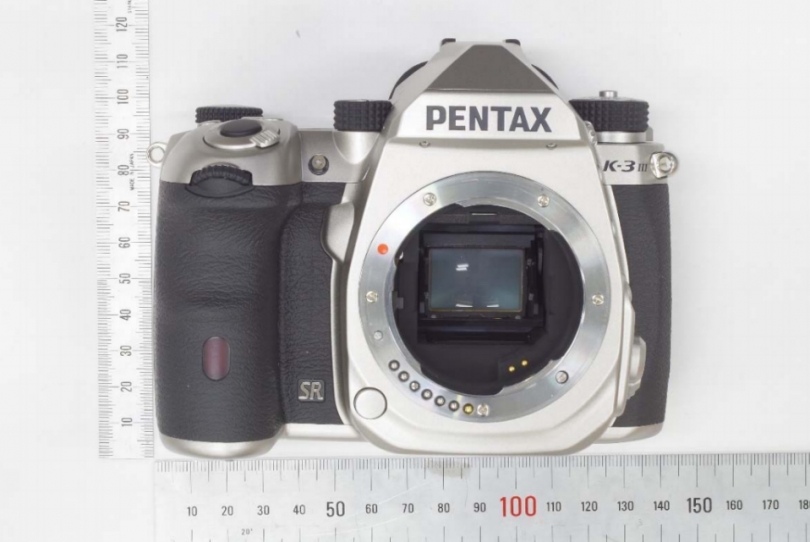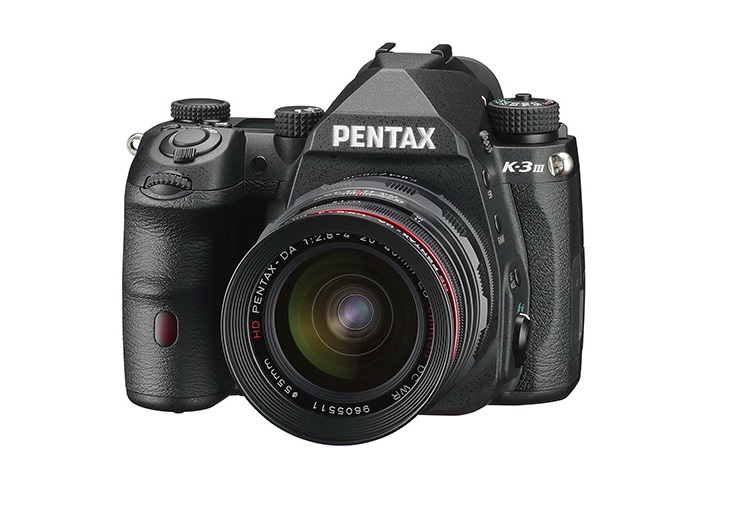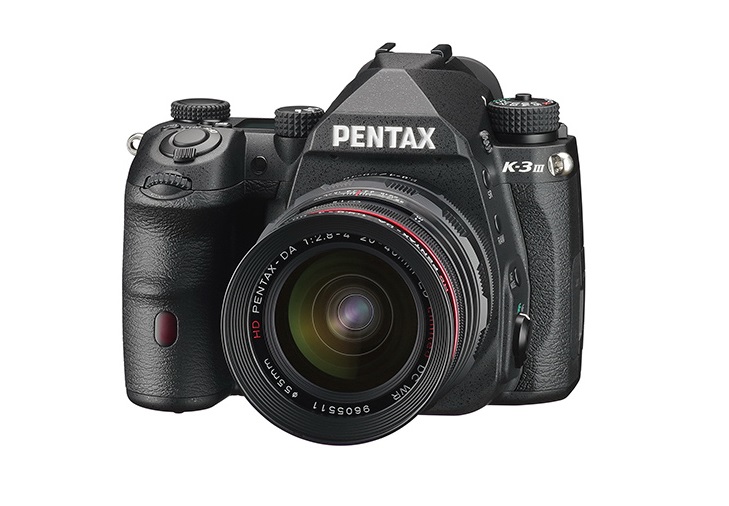
Hands-on with Ricoh's Pentax K-3 Mark III At long last, it's here: Ricoh's Pentax K-3 Mark III. We've known about its eventual existence in some form or other since development announcements in 2019, but we were still a bit taken aback by just how much reworking Ricoh has done on this camera; it shares a lot of its design and handling DNA with the previous model, but on the inside, just about everything is brand new.
So without further ado, let's take a little tour of Ricoh's latest flagship APS-C DSLR.
Grip and overall design
First things first, this is unmistakably a Pentax DSLR, from the angular lines surrounding the pentaprism viewfinder to the deep, comfortable grip. The magnesium-alloy body feels incredibly solid and secure, and the K-3 III comes with the same claims of extensive sealing that we have come to expect from Pentax cameras.
To be certain, if you're looking for a petite camera, the K-3 III (and, well, most DSLRs at this point) shouldn't be on your shopping list. But if you like the size and extensive external controls that come with a high-end DSLR, the K-3 III won't leave you wanting.
New sensor
At the heart of the K-3 Mark III is a new 26MP APS-C sensor, likely related to the sensor seen in recent Fujifilm cameras (but with a traditional Bayer color filter array instead of Fujifilm's trademark X-Trans design). That sensor should provide outstanding image quality and fast readout, but it doesn't come with any form of on-sensor phase-detection autofocus.
While this won't impact viewfinder shooting, photographers using live view and framing up their images (or video clips) on the rear screen will have to make do with the hunting associated with contrast-detect autofocus.
Stabilizer, autofocus and metering sensor
The sensor sits inside a redesigned Shake Reduction mechanism, giving users around 5. 5 stops of compensation, which is the most we've yet seen from a DSLR. An all-new SAFOX 13 autofocus module is fed light when the mirror (not seen here) is flipped down, and that module comes with 101 autofocus points (25 cross-type).
It works in tandem with a new high-res metering sensor, and Ricoh says that machine-learning algorithms and new movement prediction algorithms have been utilized to improve tracking performance (we'll test this when we have a fully reviewable camera on hand).
Top plate controls
Around the top of the camera, you get a rather smaller LCD display for your settings than the previous K-3 model, but it packs in a similar amount of information. As a trade-off, you gain a second customizable control dial for your thumb, seen here at far-bottom-right. This can be assigned to one of 22 possible options, and a button toggles between up to five of those for you.
Just above the screen is a dial dedicated to switching between stills, live view (shooting on the rear display) and movie shooting. There's the familiar power-switch + shutter button combination that falls comfortably under your right index finger (and the shutter button mechanism has been redesigned for more durability as well as a more subtle response).
Along the left shoulder of the camera is the main mode dial as well as an option to lock or unlock its operation. If it's locked, you must press the middle button in the mode dial to turn it, while you don't need to do so if it's unlocked. Also, did you notice there are no fewer than five custom settings banks?
Rear controls
The rear of the Pentax K-3 Mark III is dominated by a fixed 3. 2" touch-sensitive display with a solid resolution of 1. 6M dots. There's also an eye-sensor under the optical viewfinder, so the screen disables itself automatically when you raise the camera to your eye: especially handy for shooting in low-light conditions.
The touchscreen by default doesn't allow you to manipulate settings on this main screen, but you can use it to navigate menus as well as zoom into or swipe between images in playback. In live view shooting, you can use it to place your autofocus area, initiate autofocus acquisition, and if you so choose, fire off a shot.
There's now an 8-way autofocus joystick which lets you place the AF point around the viewfinder frame, and of course the Pentax 'green button' has a prominent spot. This button can, among other things, help users reset their exposure parameters when in various shooting modes.
Optical viewfinder
The K-3 III's optical viewfinder has been entirely redesigned. It now has a transparent display panel in the viewing path, rather than the display of a separate panel projected into the finder, and the result is a claimed 10% increase in overall brightness compared with the previous model.
The finder offers an impressive 1. 05x magnification (equivalent to to 0. 68x magnification on a full-frame camera). This is the best we've seen on an APS-C DSLR, though there are a few mirrorless APS-C models that have larger equivalent magnifications for their electronic viewfinders. Still, if you prefer an optical viewfinder, this one is perhaps the best you'll find on a crop-sensor camera.
Main ports and side controls
As we mentioned in a previous slide, the K-3 III is brimming with external controls; along the left side of the camera, you'll find dedicated autofocus controls and further dedicated controls for image quality and Shake Reduction settings (and these buttons are customizable).
In terms of ports, the K-3 III comes with both microphone and headphone ports to support its up-to-4K/30p video capture, as well as micro HDMI and USB-C. It's USB-C port can charge the camera, and no external charger is included in the box.
Storage
Along the right side of the camera are a pair of SD memory card slots, one of which is UHS-II compatible (we'd have loved to see them both carry this designation though, given the fast 12fps maximum burst speeds the K-3 III is capable of). Underneath those, protected by a rubber plug, sits a remote socket.
Battery
In terms of power, the K-3 Mark III uses the same D-LI90P battery as the K-1 Mark II; here it provides a CIPA rating of 800 shots per charge, though it won't be uncommon to get double that number. Outright battery stamina is one area where the DSLR still truly reigns supreme.
And battery grip
. . . But if 800 rated shots per charge isn't enough for you, well there's an accessory battery grip available for the K-3 Mark III to boost that by a significant number. It comes with the expected duplicate controls (including an 8-way joystick and the newly designed shutter) on the rear for more comfort when shooting in portrait orientation, as shown here.
Hands-on with Ricoh's Pentax K-3 Mark III
And that about does it for our tour of Ricoh's Pentax K-3 Mark III. Thanks to rapid product cycles and a collectively short-ish memory of much of the consumer public (or perhaps just human beings in general), it may seem almost anachronistic to release an all-new flagship DSLR in the spring of 2021. However, our initial impressions are positive.
It's clear that the Pentax K-3 Mark III is a high-end DSLR for high-end DSLR users. Those that like a pronounced grip, a plethora of external controls, and the feel of an optical viewfinder will find a compelling combination here. We've yet to be able to do much shooting with the camera, but expect our in-depth evaluations of image quality, autofocus and video performance to come as soon as possible, once we've received a reviewable sample.
What do you make of the Pentax K-3 Mark III? Let us know in the comments.
. dpreview.com2021-4-2 16:00





